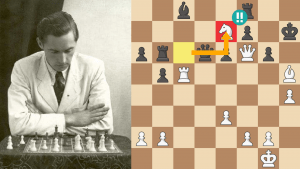
Learning An Opening: To Memorize Or Understand?
Dave asked for my opinion on a line in the Two Knight’s Defense. He wrote:
1.e4 e5 2.Nf3 Nc6 3.Bc4 Nf6 4.Ng5 d5 5.exd5 Na5 6.Bb5+ c6 7.dxc6 bxc6 8.Be2 h6 9.Nf3 e4 10.Ne5 Bc5. Here there are a few moves to play. The move I’m looking at is 11.0-0 where both Davies and Emms both say it’s Black who must justify his play. 11.0-0 Qd6 12.Ng4 Bxg4 13.Bxg4 h5 14.Be2 Ng4. After 15.g3 I think 15...Nxh2 is very playable. So, after 13.Bxg4 hxg4 14.g3 is it Black who must tread carefully or White?”
JS: Dave, I rarely discuss openings, and when I do I try to avoid gambits. However, once in a while a chess player has to embrace his long lost childhood, let the pieces fly, and risk humiliation, since I am not up to date on these things! But, just for fun, let’s take a look.
Before doing so, I want to talk a bit about basic opening understanding. A lot of people think that memorization is the most important part of learning an opening. This is not true. Besides, in amateur chess most opponents will leave the main lines quite early.
Thus, what IS important is to know the ideas of your opening, the typical plans, the typical tactics, and what the pawn structures mean. A bit of memorization is useful, but the other things I mentioned are much more important. That way when your opponent tosses a move that has nothing to do with the opening, you will be on top right away since the opponent won’t know what the position needs, while you will at a glance.

Of course, if you have a great memory and lots of time to learn all the complex sequences of moves, then go for it. But if you have a job (meaning less time) or a poor memory, don’t despair! Understanding will beat out memorization in the vast majority of situations.
I’ll back this up with a tale: I was paired in the 1998 National Open with a 2100 player who surprised me by making most of his moves without any thought at all. It turned out that he had played most of the moves in dozens and dozens of blitz games with excellent results. I didn’t have any memorized sequences, just a clear understanding on how to play such positions. Here’s what happened:
Unfortunately (or fortunately...depends what you’re after) Dave asked me about an extremely complex opening that does demand a great deal of memorization. Nevertheless, there is still room for understanding. For example, in many lines Black is a pawn down but has lots of dynamic compensation.
If White leaves the “book” then Black will have to understand that he needs to play dynamically or White will catch up in development, solidify his position, and then make a touchdown with his extra pawn.
Before continuing, let’s take a look at two other options for White:
8.Qf3
8.Bd3
OK, let’s return to the position after 8.Be2:
Now White tries three different responses: 11.f4, 11.c3, and Dave’s line, 11.0-0.
11.f4?
11.c3
11.0-0
We have finally returned to Dave’s question, which is whether or not 11.0-0 is playable. Castling short at this particular moment looks like it walks into some dangerous situations, but perhaps things aren’t as bad as they seem. Or are they even worse?
Dave, in the 11.0-0 Qd6 line, unless you want to grovel for a draw after 12.d4 Qxd4 13.Qxd4 Bxd4 14.Nc4 Nxc4 15.Bxc4 0-0 16.Nc3, or commit suicide with 12.Ng4, go for 11.c3, which is interesting and offers chances for both sides. 11.0-0 Qd6 12.Ng4? Bxg4 13.Bxg4 h5 looks like a catastrophe.
Please keep in mind that the Two Knights Defense (1.e4 e5 2.Nf3 Nc6 3.Bc4 Nf6 4.Ng5) is still a completely unclear opening. And, since it’s been around for a long time there is massive amounts of analysis to crawl through. Thus, this little dance through this fascinating journey of dynamics and tactics is just a small taste of what’s possible.






